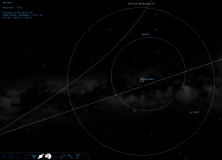Celestia is a 3D program using OpenGL, which means you don't need much computer graphics (anyone can run this program).
We can zoom in and out our known Universe. The distance of the various stars and the data about their colour, along with its name, etc are available. It is really easy to browse through the solar system and see the planets and their moons revolving in real time and we don't need a telescope. We can freeze the time or set the time to go back or forward, so that we can see the positions of our earth, sun, and different stars. The data we get from the program is fairly correct.
The settings in the program can be adjusted so that it would display the asteroids, comets, galaxies, stars, planets and nebulae, etc along with the orbits, and the constellations with their names in Latin, Comet tails, the celestial grid with the angle markings, and constellation borders. We can filter the number of stars visible by specifying the magnitude or the distance (in some light years).
Scripts are files that can automate the program to create a story about the universe, or to simulate
Many astronomical objects are not included with Celestia, which can be downloaded as add-ons. The program is open source, which means more development in the program features / extensions and scripts. "http://www.celestiamotherlode.net" houses the most comprehensive collection of Celestia add-ons and scripts.
Since this program uses data that are not complete, many simulations on distant objects are not accurate. This is not a limitation of the program, but that of our science. more

A fantastically realistic 3D model of Earth with great educational content!

Simulation and visualization tool for teaching and exploring astronomy.
Comments (6)